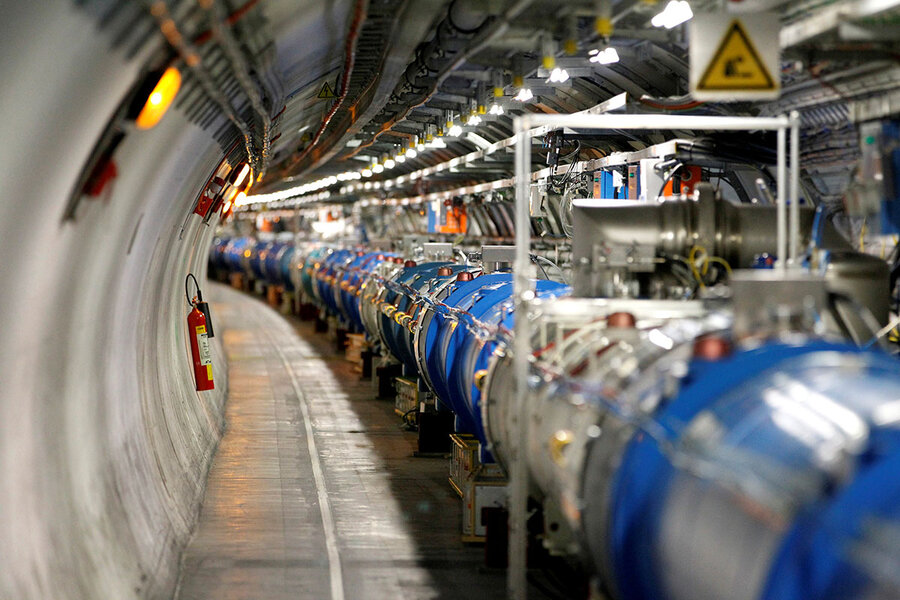Fusion breakthrough explained: What are quarks again?
Loading...
“Quark fusion” may sound like “Star Trek” technobabble, but a recently confirmed particle could be the result of this process – an explosive reshuffling of some of nature’s smallest constituents.
Q: What are quarks again?
You’re looking at quarks right now. Magazines, screens, and air are made of atoms, and atoms are largely made of protons and neutrons – which are the most familiar examples of the three-quark bundles that physicists call baryons.
Quarks come in six varieties: up, down, strange, charm, top, and bottom. Up and down quarks form protons and neutrons, while the unstable and much heavier strange, charm, top, and bottom quarks tend to transform into lighter particles fractions of a second after being created.
Q: What is quark fusion?
Fusion describes a general process in which particles recombine to form new particles, because the new particles need less energy to exist than the old ones did.
According to a paper published online in Nature on Nov. 1, researchers have calculated the energy savings that would result if two charmed baryons (three-quark bundles including a charm quark) collided and shuffled their bits around to spit out a neutron (up-down-down) and a doubly charmed baryon (up-charm-charm). That energy output was unremarkable, but then the researchers considered what would happen if a similar fusion reaction took place between quark bundles featuring the much heavier bottom quark. “It was a shocker,” says coauthor Marek Karliner, a physicist at Tel Aviv University. The event would release about eight times as much energy as a nuclear fusion reaction.
Q: Does quark fusion really happen?
Dr. Karliner’s calculation rests on an observation made in July by the Large Hadron Collider beauty experiment (LHCb) at the LHC, a powerful particle accelerator outside Geneva. The experiment confirmed the doubly charmed baryon’s existence and measured its mass. The mass matched previous predictions, giving Karliner the confidence to extend his calculation to heavier particles.
Admittedly, quark fusion is not the only way to make the doubly charmed baryon seen in July, and whether this process really plays out in the LHC is an open question. “I would presume the quarks form [the doubly charmed baryon] straight away and do not use the convoluted way described by Karliner and [coauthor Jonathan L.] Rosner,” Patrick Koppenburg, a physicist involved with LHCb, writes in an email.
Karliner points out that other baryons often undergo similar quark-swapping and that there’s no reason to suspect that the charm or bottom versions are any different. Dr. Koppenburg agrees that the reaction is “not forbidden,” echoing a common quantum physics refrain: All that is not forbidden is mandatory. In other words, quark fusion probably happens on occasion, even if the LHC can’t bear witness.
Q: Why does this calculation matter?
Talk of powerful fusion reactions may conjure up fears of new weaponry or hopes of a novel energy reactor, but physicists insist neither will happen. Thermonuclear bombs and nuclear fusion reactors need stores of hydrogen fuel, but bottom quarks tend to evaporate after a millionth of a millionth of a second. “Nature has been very kind and does not allow us to make such a terrible reaction,” Karliner says.
Rather, the weighing of the doubly charmed baryon and the calculation of the bottom quark’s theoretical fusion energy represent steps forward in physicists’ understanding of the force that binds quarks into bundles and those bundles into atoms.
“Every little bit of information we get about the nuclear strong force is important for understanding this force and figuring out ways to do some kind of engineering with it,” says Gene Van Buren, an experimental physicist at the particle accelerator at Brookhaven National Laboratory, located on Long Island in New York. However, weaving the strong force into technology in any form will take many decades, he says.
Q: What does this have to do with nuclear fusion?
Only the name. The reaction that lights up the sun relies on gravity squeezing together protons and proton-neutron pairs tightly enough that the strong force clumps them into triplets and quadruplets. The process of packing the particles more tightly releases energy (but no quark-swapping occurs).
It’s this phenomenon that many hope to someday harness for bountiful, carbon- and radioactivity-free energy. Instead of gravity, scientists have been trying to use magnetism to pack protons tightly enough that the clumping gives off more energy than the magnets consume. That dream has proved elusive: A 1997 record of producing 16 megawatts of energy for the price of 24 megawatts still stands.
As research into controlling the violent fusion process advances at small reactors around the world, construction of what aims to be the world’s first energy-profitable reactor has begun in France. If successful, the colossal International Thermonuclear Experimental Reactor (ITER) will produce 10 times as much energy as it takes to run it when it becomes fully operational in the 2030s.








